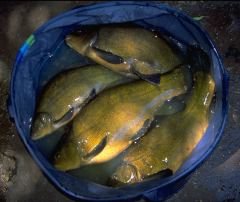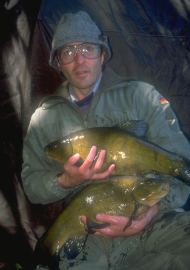I usually begin my tench fishing campaign around the end of March to mid-April, depending on the weather, for tench are in far better condition at this time than they are several weeks hence, in the old season proper, when they’re bloated with spawn. My tench fishing is relatively easy for about five or six weeks, providing the water isn’t hammered, with the tench taking big baits like whole lobworms, big chunks of luncheon meat, several grains of sweetcorn on an 8’s hook, and bunches of maggots and casters on a 10’s. Following those early weeks the tench soon wise up to what food (bait) bites back, and react with great suspicion. 
Up till then I can get away with using fairly heavy tackle as well as big baits, no matter whether I’m legering or float fishing, with a 6lb reel line to a 5lb hook length to a heavy gauge hook being the norm. Bites are generally very positive, legering indicators smacking up to the butt ring, and reel handles spinning wildly, or floats either popping up through the surface to lie flat, or disappearing beneath the surface in the twinkling of an eye. All of which makes for great fishing in anybody’s book, and notwithstanding serious hindrances like family holidays, etc, you make hay while the sun shines.
The next thing you know bites are getting fewer, or you think they are, until you examine the bait and find the end of a maggot has been nipped, or even crushed completely; or a grain of sweetcorn shelled, and not an indication to show for it. You then hair-rig the bait and play around with bolt-rigs and other set-ups. Float fishing becomes the best method, so that is what you do whenever you can, and maybe you begin to see, and hit, more bites. From there you experiment with different shotting patterns and try the lift-method, which is excellent, and probably the most sensitive float rig of all when set up correctly. But even that doesn’t last, for as time goes on; as natural foods multiply, and the tench become more educated to what is dangerous, hooked fish become hoped for rather than expected, and your tactics change to fishing for bites rather than fishing for fish. Obviously, you hope one leads to the other, but you are well aware that that may not be the case.
The usual first reaction is to reduce line strength and hook size, which may well bring more bites. But there is no need for such drastic measures just yet, for there are a few other things we can do to bring more bites. Or should we say convert more bites to fish on the bank?
The increase in natural food is the main cause for concern – initially – for it makes our baits that much less attractive. Where bunches of three or more grains of corn, maggot or caster, big lobworms and lumps of luncheon meat, and other big baits were taken confidently, they are now refused, or played around with to the point where the bite becomes almost unhittable. To counter this increasing preoccupation with natural food we have to increase the amount of free feed we introduce, using a food that is small and plentiful, with the aim of preoccupying the tench on that; a food that is also a good hookbait, small, but not too small it can’t be used on a heavy gauge hook of no less than a size 16 – which is usually strong enough to land any size of tench where there are no really bad snags.
The best baits to wean tench away from natural food are maggots and casters. Casters are the best bait of all for holding tench in a swim. They are light enough to sink slowly and rest on top of weed and silt, stay there until they are eaten, and make excellent hookbaits. The dark, floating casters can give you an extra ace to play with too, in that they can provide you with a semi-buoyant hookbait. Maggots are the next best baits, but will crawl into weed and burrow occasionally into silt. But this can be countered by using scalded, dead maggots. Once you achieve preoccupation in tench with caster it is possible to make some really big catches, they love them so much. The big advantage with both maggot and caster is that the tench never seem to lose interest in them, or become wary of them as they do with, for instance, sweetcorn.
The next step is to use small hookbaits, preferably single items of the free feed you’ve been throwing in. If you’ve stayed with corn, then present a single grain on a 14’s, rather than two on a 12’s. Double caster or maggot is usually acceptable, but if you’re still experiencing finicky bites, or have evidence (such as shelled casters or sucked maggots) that the tench are wary of the bait, then try a single. If you’re careful, one caster can just about stand having a 14’s hook buried in it. But don’t hesitate to drop down to a 16’s, or even an 18’s if you feel you have to, using heavy gauge hooks rather than fine or medium gauge ones. 
The next stage, if you’re still struggling to see bites, or convert bites into fish in the net, is to reduce the diameter of your hooklength, which does not necessarily mean you have to fish lighter. Read the labels of all the lines in your tackle shop and you’ll be surprised at the variation in diameter of lines for a given strength. You’ll probably find at least one that is thinner than the one you are using, yet with the same breaking strain. The pre-stretched lines are no problem if you use Grinner and Palomar knots, and ensure you tighten them carefully, using spit as a lubricant.
Eventually, there is only one way to go when the bites disappear again. You have to go lighter. Even finer lines and smaller, finer-wire hooks, and certainly single, small baits. Providing there are no exceptionally bad snags it is possible to land big, hard-fighting fish on light tackle. Just make sure everything is balanced correctly. In particular you should ensure the rod is not too heavy for the line and when it comes to playing the fish, think of it as persuasion rather than punishment, encouragement rather than correction. Match anglers prove regularly that big fish can be landed on light tackle, and when it comes to the crunch; when you have to fish for bites to catch fish, and throw caution to the winds, you may as well go for it positively and confidently. There is no other way.










